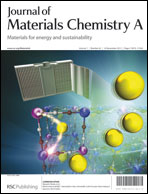Template-free solvothermal fabrication of hierarchical TiO2 hollow microspheres for efficient dye-sensitized solar cells†
Abstract
Hierarchical TiO2 hollow spheres consisting of anatase nanoparticles are successfully prepared via a simple one-pot solvothermal method by using titanium n-butoxide and oxalic acid dihydrate as the precursors. This detailed investigation reveals that apart from the reaction time, the molar ratio of oxalic acid dihydrate to titanium n-butoxide in the precursor reagents plays a key role in the crystallization of TiO2 as well as the formation of the hollow architecture. As confirmed by UV-vis diffuse reflectance spectroscopy, electrochemical impedance spectroscopy (EIS), intensity modulated photocurrent/photovoltage spectroscopy (IMPS/IMVS) and open-circuit voltage decay (OCVD) measurements, the as-prepared hierarchical TiO2 hollow microspheres exhibit a stronger light scattering ability and extended electron lifetime compared to commercial P25 nanoparticles, which makes it a promising photoanode material for dye-sensitized solar cells (DSSCs). As a result, a power conversion efficiency of 6.33% is obtained for the hierarchical TiO2 hollow sphere-based DSSCs, which is lower than the value of P25 nanoparticle-based cells (7.69%) due to the significantly lower dye adsorption. However, the efficiency of the DSSCs can be enhanced to 8.76% when a bi-layer structured photoelectrode composed of P25 nanoparticles (dye adsorption layer) and hierarchical TiO2 hollow spheres (light scattering layer) is used. The great improvement in photovoltaic performance is mainly due to the excellent light scattering properties, relatively high dye adsorption and the slower recombination rate of the bi-layer structure.


 Please wait while we load your content...
Please wait while we load your content...